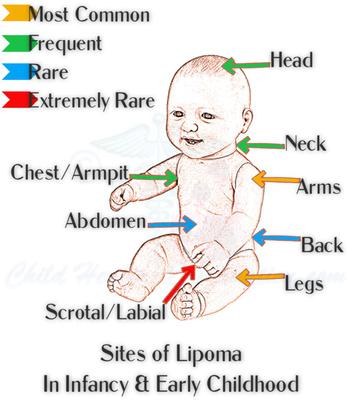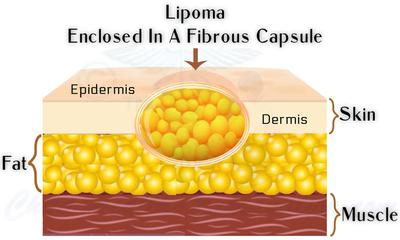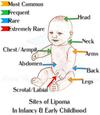Soft Lump on Baby's Upper Arm
by Ryan
(England)

Lipoblastoma: The Infantile Lipoma
Doc said it is lipoma, a fatty lump, nothing to worry about. My 3-month old daughter has a painless soft lump on the top of her upper arm, which moves around when touched. She is otherwise a healthy baby. No other abnormal signs or symptoms have been noticed. Has anybody else experienced similar tumor-like growth in a healthy infant?
The Expert, Ren Chats Answers
Lipoma in infancy is one of the several types of fatty tissue tumor, which are classified into nine distinct groups. The most common variety seen in infants and children is called Lipoblastoma, the infantile lipoma.
Though the name provokes anxiety, these tumors are not malignant. Nor are they associated with any form of inflammation. It is an abnormal growth of embryonic white fat. It consists of lipoblasts, the fat-cells producing cells that continue to multiply even after birth. The lump, however, remains localized to the site of its origin.
Incidence and Prevalence:
Lipoblastoma presents early in childhood, generally before 3years of age, as a small solitary soft tissue mass under the skin. Almost half of these cases get diagnosed during infancy. Boys are more frequently affected than girls.
Nevertheless, the exact prevalence and incidence of infantile lipoma are not known. It is exceedingly rare in infants. When it does show up in early infancy or is present from birth, a genetic cause should be ruled out. More so, if the affected baby has an associated abnormal physical finding like small or big head size.
What causes abnormal fatty tissue proliferation?:
Though the precise cause of lipoma is obscure, genetics appears to play a role in 2 to 3% of affected children. An association with chromosome 12 has been established in the solitary lipoblastoma. The affected children’s chromosome 12 shows a fusion of the high mobility group of genes and the lipoma preferred partner gene. Other documented chromosomal abnormalities are deletions of Chromosome 2 and rearrangement of Chromosome 8.
Clinical presentation:
Given that the fatty tissue is spread all over the body, the tumor-associated with it can appear anywhere. But lipomas usually arise on limbs and trunk, the upper arm near the shoulder being the most common site in children and infants (See the Fig. given above). The head and neck are the next common, but those that grow within the chest or abdomen are extremely rare in children. Intra scrotal lipoblastoma and its association with accessory scrota have been documented.
A lipoma is typically a slow-growing tumor under the skin, which is neither attached to overlying skin nor any other tissues underneath (See the Fig. given above). The skin overlying it remains notably unaffected.
The affected baby does not show any signs of discomfort, not even when the lump gets accidentally pressed or pinched. When parents first notice the abnormality, the ball-like growth is already at least about 2cm in diameter.
On trying to feel the soft lump between fingers, it slips off easily. This is known as Slip Sign. A positive slip sign is diagnostic for these rare fat-filled tumors, which are doughy to touch and generally painless.
Complications:
In most cases, lipoblastoma has no ill effect on a child’s growth and development. It does not spread to other sites in the body as cancer does. However, if allowed to grow unchecked, it could cause compress the surrounding structures and may begin to hurt. Local pain and tenderness, tingling-numbness due to nerve compression, and limitation of the range of movements of the limb have been reported in a few children with superficial lipoma.
Treatment:
1. Regular follow-up consultations are a must
Infantile lipoma, though slow-growing, can reach considerable sizes that would jeopardize child health.
2. Complete excision of the tumor is curative
Lipoblastoma certainly does not disappear on its own. Will need to be removed surgically at some point in time, which will be decided on follow-ups by the attending doctor.
In some, local recurrence may occur if the tumor is not completely removed during the surgery. But most lipomas in infants and children are solitary capsulated superficial fatty lumps and can be removed as a whole.
Liked what you read just now? Pay it forward!












